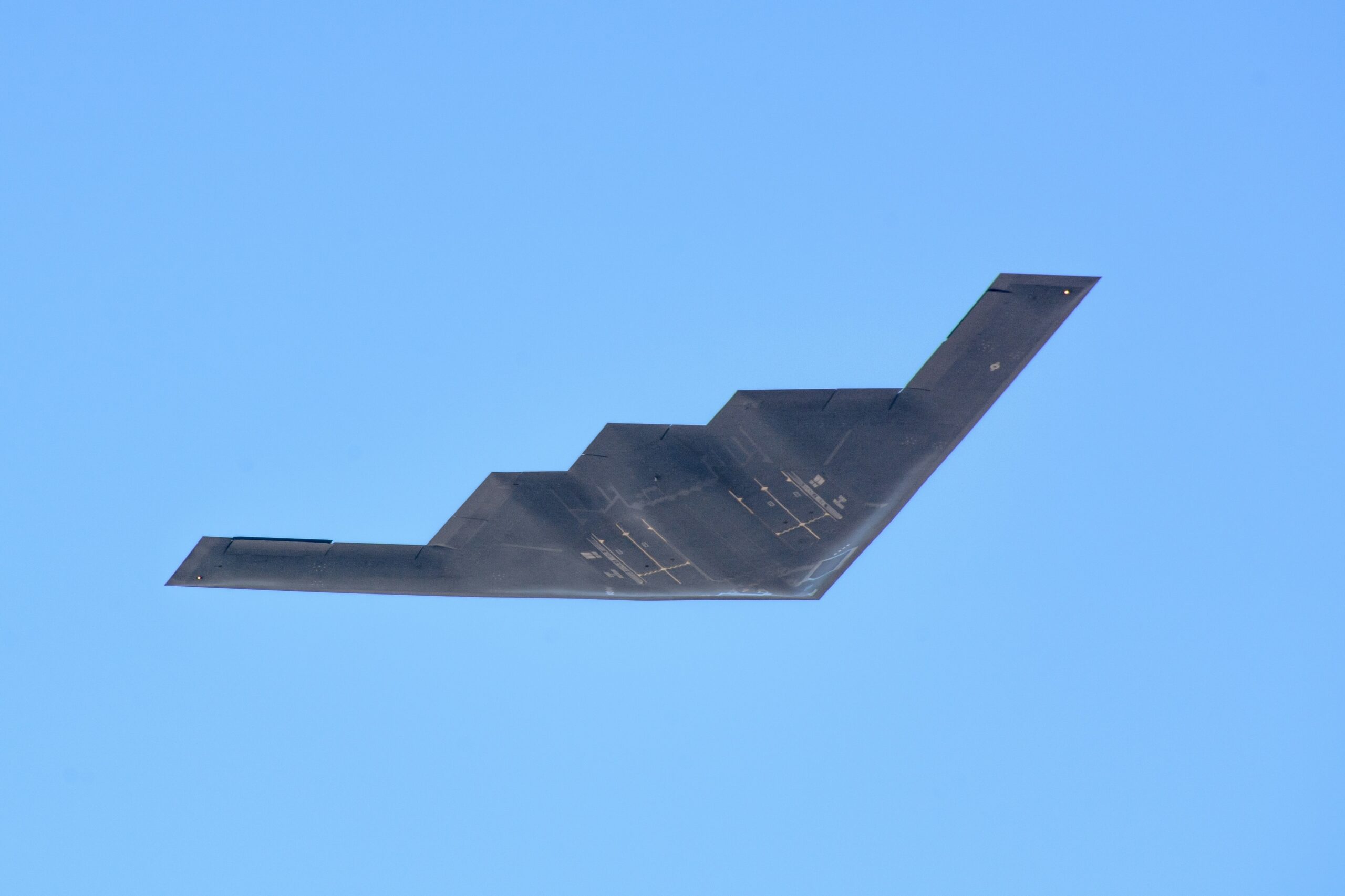Northrop Grumman holds the pen on a one-year deal worth $9.33 million. Work kicked off in Palmdale with small teams, not big ceremonies. Staff chased parts lists, rewired mock-ups, and traced cables across cold hangar floors. The job map sets three core goals:
- Fit the jet for 250-pound class Small Diameter Bomb II rounds.
- Refresh cockpit screens that still rely on aging analog guts.
- Prove that selected radar modes can track a truck that keeps rolling.
Each line sounds neat, but hidden tables show hundreds of sub-steps. The program leads squeeze tasks into a tight calendar. They admit the timeline feels bold, yet nothing about stealth bombers ever went smoothly first try.
Workers face a mixed fleet; no two airframes share the exact same scars. One tail shows sun fade, the next carries fresh sheet metal patches. That fact alone twists schedule math, and planners add buffer days though maybe not enough.
Small Diameter Bomb II and Radar Upgrades Extend B-2’s Tactical Reach
Past strikes leaned on fixed grids—bridges, power nodes, runways. Modern foes ditch that model; they split gear into small convoys and shift gear each night. Commanders who flew in Iraq recall chasing pickup beds that turned into launch pads. Satellites spot the threat, but by the time a heavy bomber arrives, the convoy already slips away.
A weapon able to adjust mid-flight breaks that loop. Missiles do some of that job, yet missiles cost steep money and eat scarce magazine space. A 250-pound glide bomb sits cheaper and lighter, letting a single B-2 haul scores of rounds instead of a handful. That math wins budget fights and wins real fights too.
Weapon Choice: Small Diameter Bomb II
The SDB II brings tri-mode seekers—millimeter radar, imaging infrared, semi-active laser. One sensor cuts through clouds, another locks heat, the last listens for an outside mark. Small Diameter Bomb II approved for operational use by the Air Force in recent evaluations. Few munitions carry that blend at this weight point. Each bomb spreads four stub wings; range stretches well past 40 nautical miles in clear air, less in heavy headwinds. Warheads slice armor with a shaped front charge while a back sleeve sprays fragments.
Key traits:
- Weight: Roughly 250 lbs, light enough to stack 8 per rotary rack.
- Data Link: Two-way channel lets a pilot retarget minutes after drop.
- Cost: Unit price lands below heavy missile levels, though still not cheap.
- Production Stage: Lot buys remain low-rate; full-rate decision still waits on flight tests.
Line crews praise the compact casing; it spares them forklift dance moves. They still gripe about delicate seeker domes, one slip chips the glass and kills a round.
Cockpit Display Overhaul and Universal Armament Interface Integration Challenges
B-2 glass panels freeze on crisp images, but guts hide 1980s boards that speak only analog voltage swings. New weapons talk digital packets. The bomber must translate both tongues without lag. Techs slot a brassboard test rig into a lab cockpit. Wires dangle loose; sticky notes mark each temporary splice.
Early code builds show jitter when radar video overlaps weapon status pages. Debuggers hunt stray refresh loops. Sometimes the cure breaks map overlays. Long nights erase those bugs one by one. A coder jokes that his eyes now see pixels even during lunch, yet he keeps typing—deadlines ignore eye strain.
Radar Modes Qualification
The bomber’s APQ-181 radar already tracks fixed points for GPS fixes. To chase a moving truck, software must filter ground clutter and predict course shifts. Engineers re-tune gain tables, tweak pulse widths, and rewrite target quality thresholds. Flight tests over California desert lanes place orange contractor SUVs as prey. Crews fly racetrack orbits; each pass logs range, speed, aspect angle.
Data dumps show mixed hits. Some runs lock fine, others drop when the SUV turns under overpass shadows. Analysts feed that truth back into code loops. Progress feels slow, but no shortcut exists. Stealth reshapes radar returns; every parameter dances with signature control rules. Mess up one limit, and the jet glows bright on enemy scopes. No one risks that.
Universal Armament Interface Path
Small bombs plug into pylons through a standard now called Universal Armament Interface. UAI copies computer USB logic—one cable, many payloads. B-2 racks never spoke that language. Mechanics must pull panels, thread new harnesses, and install smarter store management computers.
UAI gives clear wins:
- Faster Integration: Future weapons slot in with less lab time.
- Common Messages: Fault codes look the same across aircraft types.
- Lower Life-Cycle Cost: Few spare boxes cover many loadouts.
Yet the change forces deeper checks. Old Mil-Std-1553 buses stay as fallback, so bridge chips juggle both flows. A single bad packet could freeze weapons once doors open at 40,000 ft. Program chiefs push for layered resets; one watchdog alone feels risky.
Testing Roadmap
The schedule splits into ground labs, anechoic chamber pulses, captive-carry flights, and finally live drops. Ground labs shake out wiring faults. Chamber runs see if seeker heads stay blind to bomber emissions. Captive flights dangle bombs but keep pins safe, recording heat soak cycles and buffeting loads.
Live tests begin at White Sands then shift to Utah Test and Training Range for moving scoring boards. Each event grades: seeker hand-off, weapon data link integrity, impact error, and bomb rack ejection loads. Range crews paint steel plates with fresh alignment grids between sorties. Dust storms stall a few sorties, burning fuel on ground idle.
Metrics feed into production reviews. A miss outside 3 meters flags a root-cause drill. No one accepts “close enough.” Small bombs carry small fillers, so aim must compensate.
Impact on Crews and Maintenance
Pilots train in T-38 chase jets first. They practice curve-in launches on slow vans mocked up as mobile radars. Sim pits mirror new layouts; switch throw count climbs yet screen logic cleans clutter, so heads-down time drops. One pilot admits he still reaches for an old push-button that vanished last month—muscle habit dies late.
Backshops stock novel spare parts—fiber optic transceivers, micro-coolers for processors, gasket sets with tighter EMI seals. Supply sergeants juggle bins already cramped with stealth tape rolls and LO sealant jars. Any extra item stings shelf budgets, yet commanders argue the payoff dwarfs the cost.
Next Modernization Layers
The MTK upgrade rides inside a longer roadmap:
- Replace high-bandwidth satellite radios now nearing obsolescence.
- Shift from eight-inch disk drives to solid-state modules.
- Add defensive lasers able to blind short-range seekers.
- Trim radar cross section through smoother inlet liners.
None of these tasks wait for the others; pipelines overlap. Program offices share manpower, and burnout risk climbs. Air Force Materiel Command rotates officers faster to keep fresh eyes but that resets context each hand-off, another small tax on flow.
Northrop Grumman’s Industrial Team and Logistics for B-2 Stealth Upgrades
Northrop Grumman leads, yet dozens of shops carry slices.
- Raytheon supplies the seeker arrays.
- Honeywell tweaks cockpit graphics drivers.
- BAE Systems tests EMI shielding.
- Boeing lends flight-test chase planes.
A distant metal-fab mill in Kansas turns bomb rack brackets on five-axis rigs. Anodizing baths run nights to beat ship deadlines. One forklift driver slides pallet corners too sharp one Monday, dinging six units, so the plant adds soft bumpers next shift. Tiny breaks stack but managers catch most before they ripple outward.
Logistics Thread
Global sustainment teams map part flows from Palmdale to Whiteman AFB, then on to forward strips. Depot chiefs fight clock cycles; stealth skins accept only limited panel pulls before wear shows. Each new cable path brings extra torque steps in manuals. Seasoned crew chiefs scrawl margin notes: “Finger tight plus one-eighth turn, NOT one-quarter.” Those scribbles save later headaches.
Training Slice
Formal schoolhouse instructors shape fresh syllabi. Lessons cover: seeker troubleshooting, UAI fault trees, radar mode steps. Students cycle through half-day sims, half-day classroom, then engine-running crew changes on real jets. Instructors toss in odd faults—frozen line-of-sight, dropped data-link handshake. Trainees sweat timers but usually find the fix. A few freeze; coaches pause, reset, walk slower.
Graduates sign off with a live two-ship sortie. They find a set of decoy jeeps, mark them, run a weapons pass, and watch dust plumes pop meters apart. Debrief screens show hit dots inside lethal radius—barely. Instructors nod, clap once, and move on.
Security and Cyber Guard Rails
New code invites new cyber gaps. Red-team hackers poke at UAI message validators, tossing malformed packets. One exploit in the lab forced a display reboot, nothing more, but still raised eyebrows. A recent Stryker-mounted laser test also revealed software weak points during field evaluation. Patches flowed inside 48 hours. Program leads vow to bake scans into each nightly build, though nights already feel too short.
Budget Hurdles
Congress eyes every modernization line. Some members question why a stealth bomber that already costs billions needs lightweight bombs when heavier JDAMs work fine. Air Staff briefs push cost-per-effect graphs: one B-2 sortie with SDB II covers more mobile targets; tanker cycles drop; overall risk lessens. Recent GAO reports highlight new F-35 deficiencies, fueling broader scrutiny of spending priorities across air platforms. The math convinces most, yet election cycles shift committees every two years, so arguments never end.
Schedule Pressures
Weather slips, part delays, test range jams—all bite. A single late radome lens can stall four integration tails. Supply chain managers scan vendor health reports weekly. If any small firm shows cash flow stress, the prime dispatches a liaison to nudge invoices faster. Lessons from pandemic years linger; nobody assumes smooth shipping.
Partner Weapons Doctrines
Allied air arms watch close. Some weigh their own SDB II buys. Britain fields smaller bomber fleets, but Typhoon loads share UAI pathways, so integration lessons hop across oceans. NATO planners sketch joint packages where Spirits clear the way, Typhoons mop up stragglers, and drones beam live feeds. A recent Sniper pod upgrade supports this type of cross-platform coordination. The concept lives on whiteboards for now, still the planners whisper that tech policies must align before metal flies.
Environmental Footnotes
Stealth coatings release solvents during cure cycles. Plant managers install extra scrubbers to trap fumes. Local councils track metrics. Reports show levels inside state rules, yet activists stay wary. Northrop PR staff hold community briefings—plain slides, open Q&A. Most residents care more about job stability than lab solvents, still they ask pointed questions. Engineers answer straight; no one spins.
Workforce Pulse
Palmdale’s line mixes gray-hair veterans with fresh graduates. Veterans carry tacit lore on cable routes and panel fits. New hires bring Python scripts and 3-D print hacks. Sparks fly some mornings—literal and figurative. A mis-read torque spec sends a rivet gun skipping, leaves a scratch on carbon skin. Supervisor sighs, files report, moves on. Such scrapes come with learning curves.
Final Steps Toward Fielding
Late-phase checkpoints loom. To cross Milestone C, the program must prove:
- Stable hardware design across three airframes.
- Software freeze with no category-one bugs.
- Training pipeline that can surge crews on demand.
Flight test officers pen sign-off packages. Every signature line pins careers; no one signs blind. Date slip risk remains real. If freeze drifts past fiscal gates, budgets shuffle, and the mountain grows steeper.
REFERENCE SOURCES:
- https://www.aero-news.net/annticker.cfm?do=main.textpost&id=D031DEF2-4C2B-4AF6-9BEA-0BC8C17579C4
- https://news.northropgrumman.com/b-2-spirit/northrop-grumman-continues-b-2-spirit-modernization
- https://www.dote.osd.mil/Portals/97/pub/reports/FY2010/af/2010b2rmp.pdf?ver=2019-08-22-112947-457
- https://www.aflcmc.af.mil/News/Article-Display/Article/2381261/small-diameter-bomb-ii-approved-for-operational-use/
- https://www.militaryaerospace.com/trusted-computing/article/14200829/smart-munitions-upgrades-cryptographic-modernization
- https://www.airandspaceforces.com/sdbiikeytob-2mtkcapability/



